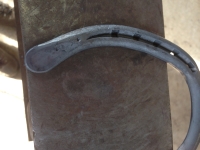Feathering the heel of a horseshoe is another way of dealing with a sore-heeled foot.
A common problem when shoeing racehorses is a tender inside heel (Fig. 1) of one or both front feet. The reason for this dominance of inside (medial) front heels being affected is very simple. A standing horse normally bears 60 percent of its body weight on the front feet and 40 percent on the back. This disparity is exaggerated by putting the horse into forward motion. The inside or medial heel is often more affected than the outside (lateral) heel because the inside heel is closer to the horse’s center of gravity.
This is why the inside heels of front feet are a problem area. If a racehorse is having foot issues, that’s the first place to check.
There are many ways to approach shoeing in a situation like this. Bar shoes, circuit plates, and pads that span across the frog are some of these methods. These are all meant to use the frog as a bridge of support, lessening the load on the heels.
Another thought, however, is to thin the shoe over the affected area. The shoe can be “feathered out” at the heel by forging it into a thinner and wider profile (Fig. 2). Doing this will reduce the intensity of impact when the hoof hits the ground.
 Fig. 1 (top): An example of a tender inside heel.
Fig. 1 (top): An example of a tender inside heel. Fig. 2 (bottom): A "feathered out" shoe is thinner and wider to lessen impact.
Fig. 2 (bottom): A "feathered out" shoe is thinner and wider to lessen impact.
Obviously, the thicker the shoe, the more distance you have available to “feather.” Some aluminum shoes have more thickness to work with. The “outer rim”(aluminum race shoe made by several manufacturers) for example is 3/8-inch thick and can be feathered out to great effect on the landing area of that shoe’s hoof.
This is another technique to diminish the impact over a sore heel. This method is the least invasive to the gait of the horse and can be done (to varying degrees) on any shoe, thereby eliminating changes to the shoeing package of that horse.
This cannot offer the same amount of relief as bar shoes, pads, circuit plates, etc., but it will reduce the size and intensity of the heel bruise in the next shoeing interval and can be done without adding new elements to the shoe. I would like to qualify that statement by saying that careful trimming and shoe fit play a big factor as well, but those elements play a huge role in any shoeing job no matter what type of shoe you have decided to use.
Of all the shoeing tricks, types of pads, new shoe styles, etc., that are available today, none will overcome a poorly trimmed hoof and a shoe that is too small. This has been true since they started shoeing horses. The feathered heel is just one more technique to use in the endeavor of successful horse racing.
Veteran Standardbred farrier Steve Stanley of Lexington, Ky., authors a monthly column for Hoof Beats, the official harness racing publication of the U.S. Trotting Association. The American Farriers Journal Editorial Advisory Board member offers plenty of practical advice that will be of special interest regardless of the type of horses that you work with. Click here to read more from Steve Stanley's Hoof Beats series.








Post a comment
Report Abusive Comment